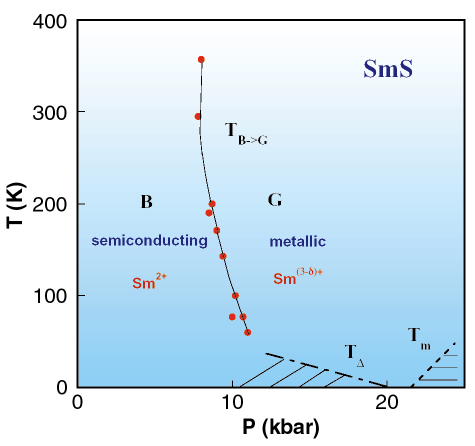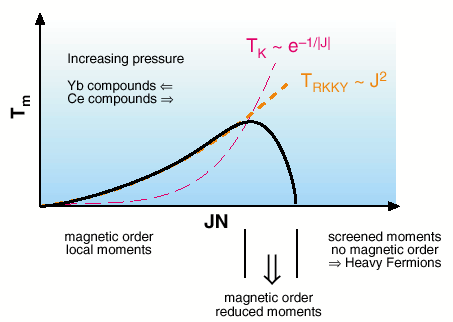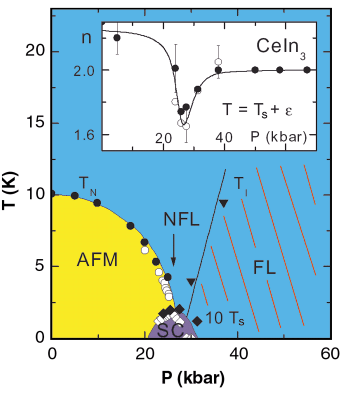- Home
- Users & Science
- Scientific Documentation
- ESRF Highlights
- ESRF Highlights 2002
- High Resolution and Resonance Scattering
- Strongly-correlated Systems
Strongly-correlated Systems
Review by J.P. Sanchez (CEA-Grenoble, Département de Recherche Fondamentale sur la Matière Condensée, SPSMS, Grenoble, France)
Most of the properties of simple metals like copper (Cu) can be accounted for by models where the conduction electrons can wander freely through the sample. In some systems, however, one cannot ignore the Coulomb interaction between electrons and the effect of exchange on their motion. These interactions lead to correlations between particles. This is best exemplified either by f-electron systems called heavy fermions, where the interactions are so strong that the effective mass of the quasiparticles amounts to several orders of magnitude higher than that of the bare electron mass, or by a class of transition metal compounds, called Mott insulators, where the on-site Coulomb energy (the cost of putting two electrons on the same lattice site) is so huge that it localises the d-electrons on each lattice site leading to vanishing electrical conductivity. The study of these strongly-correlated electron systems (SCES) is the foremost area of research in contemporary condensed-matter physics. The challenge is double, the correlations can be very difficult to deal with theoretically and the experimental advances require extreme conditions (very low temperature, high pressure, and/or high magnetic field). The interplay and competition between spin, orbital, and charge order in these materials was shown to lead to a rich variety of behaviours. Besides the traditional branches of SCES such as the non-magnetic Kondo many body singlet, valence fluctuations or heavy fermions, new topics have emerged over the years [1]. Among them one may mention:
- the study of rare earth or actinide-based heavy fermion superconductors with focus on compounds where unconventional superconductivity coexists with magnetic order (e.g. UPt3, UPd2Al3, ...).
- the tuning of the Kondo coupling through quantum-critical points (QCP) either by doping, application of pressure or external magnetic field with possible observation of non-Fermi liquid (NFL) behaviour and emergence of superconductivity when Tm (Néel or Curie temperature) goes to zero (e.g. CeIn3, UGe2). It is worthwhile emphasising that the mechanisms which describe the QCP in rare earth or actinide compounds may control the physics over a much wider domain (e.g. the high temperature superconductors close to the optimal doping).
- the continuous interest in cuprate superconductors (high Ts, ruthenates like Sr2RuO4) or in "new" transition metal oxides such as the vanadates (NaV2O5) or the spin ladders (Sr14Cu24O41).
- the organic metals which offer the possibility of tuning the transition between superconductors and antiferromagnetic insulators by changing the ratio U/W between on site Coulomb correlation energy (U) and the bandwidth (W).
- the general class of manganites based on the perovskites parent compound LaMnO3, which, beside colossal magnetoresistance, exhibits a plethora of different behaviours (metal insulator transition, charge or orbital ordering associated with lattice distortions, ferromagnetism, etc.) by changing the chemical composition or by varying an external parameter such as pressure or magnetic field.
The selected highlights presented here are devoted to studies on a variety of compounds. Some have been intensively studied in the past and are now revisited such as YbInCu4 and YbAgCu4 the mixed-valent heavy fermions, SmS the so-called Kondo insulator, and the U(In1xSnx)3 series. There is also one new subject, MgB2, which although known for a long time was only recently shown to be a new superconductor.
Mixed valence phenomena occurring in rare earth compounds attracted considerable attention in the seventies and early eighties [2]. Such effects arise when two 4f shell configurations 4fn and 4fn1 have nearly degenerate energies or in other words when the 4f levels are close to the Fermi energy. The ground state of a mixed-valence compound is a quantum mechanical mixture of two (or more) electronic configurations as explained phenomenologically by the valence fluctuation model (or theoretically by the one-impurity Anderson model) and shown experimentally by e.g. photoemission measurements (characteristic time 1017 s) which present features due to both 4fn and 4fn1 configurations. The leading interaction in such systems is the Kondo temperature TK  exp (-1/IJIN), where J is the exchange coupling (hybridisation strength) between the 4f and the 5d conduction electrons, N is the 4f density of states at the Fermi level. The most elegant way to tune TK is the application of pressure (P). TK decreases (increases) with P for mixed valent Yb or Sm (Ce) compounds and drives the materials towards a trivalent (tetravalent) state. The rare earth valence is generally determined either from Vegards law analysis of the lattice parameters or from magnetic susceptibility or spectroscopy methods. The latter techniques (e.g. photoemission, X-ray absorption) led in the past to controversial results owing either to their high surface sensitivity or to complex deconvolution of poorly-resolved spectra. Dallera et al. have overcome all these pitfalls by using resonant inelastic X-ray scattering (RIXS) which was proven to be a bulk-sensitive method to trace rare earth valency with unprecedented accuracy.
exp (-1/IJIN), where J is the exchange coupling (hybridisation strength) between the 4f and the 5d conduction electrons, N is the 4f density of states at the Fermi level. The most elegant way to tune TK is the application of pressure (P). TK decreases (increases) with P for mixed valent Yb or Sm (Ce) compounds and drives the materials towards a trivalent (tetravalent) state. The rare earth valence is generally determined either from Vegards law analysis of the lattice parameters or from magnetic susceptibility or spectroscopy methods. The latter techniques (e.g. photoemission, X-ray absorption) led in the past to controversial results owing either to their high surface sensitivity or to complex deconvolution of poorly-resolved spectra. Dallera et al. have overcome all these pitfalls by using resonant inelastic X-ray scattering (RIXS) which was proven to be a bulk-sensitive method to trace rare earth valency with unprecedented accuracy.
 |
|
Fig. 57: (T, P) phase diagram of SmS showing the phase boundary between the black (B) and golden (G) phases. The lines T |
The interest of SmS started with the discovery that this compound undergoes a first order isostructural (NaCltype) pressure-induced semiconductor (black phase) to metal (gold phase) transition at the incredibly low pressure of 6.5 kbar and that the metallic state is mixed valent while the Sm ions in the black phase are divalent or nearly so. At the critical pressure Pc ~ 6.5 kbar the Sm 5d and 4f bands overlap as a result the 4f electrons spill into the 5d band leaving a 4f5 state. Nowadays it appears that the temperature-pressure phase diagram of SmS (Figure 57) is much more intricate, particularly concerning the nature of the golden phase. At low temperature (below T ) and up to 20 kbar the high pressure SmS phase actually behaves like a semiconductor but with a small energy gap (several meV) often named hybridisation gap,
) and up to 20 kbar the high pressure SmS phase actually behaves like a semiconductor but with a small energy gap (several meV) often named hybridisation gap,  . Trivalent Sm ions are expected to be stabilised above 20 kbar in the metallic phase and band structure calculations predict the occurrence of a magnetic ground state at Tm although all attempts have failed to find magnetic order and thus a QCP. The valence transition at Pc also manifests itself in lattice dynamics, investigated in the past by neutron scattering in a restricted pressure range (up to 7 kbar) and extended to 80 kbar by Raymond et al. using inelastic X-ray scattering (IXS). These measurements enabled the characterisation of novel phonon anomalies in the longitudinal acoustic mode.
. Trivalent Sm ions are expected to be stabilised above 20 kbar in the metallic phase and band structure calculations predict the occurrence of a magnetic ground state at Tm although all attempts have failed to find magnetic order and thus a QCP. The valence transition at Pc also manifests itself in lattice dynamics, investigated in the past by neutron scattering in a restricted pressure range (up to 7 kbar) and extended to 80 kbar by Raymond et al. using inelastic X-ray scattering (IXS). These measurements enabled the characterisation of novel phonon anomalies in the longitudinal acoustic mode.
 |
|
Fig. 58: Possible ground states resulting from the competition between the Kondo and RKKY interactions. Tm is the ordering temperature and JN is the f-d exchange coupling times the f density of states at the Fermi energy. |
When the valence of the f-ion is an integer (or close to) and the corresponding total angular momentum of the ion is non-zero (i.e. the ion is "magnetic"), the ground state of the system is determined by a delicate balance between the Kondo effect, which screens the local f-moment towards a singlet state, and the Ruderman-Kittel-Kasuya-Yosida (RKKY) interaction (TRKKY  J2) responsible for the magnetic exchange coupling (Figure 58). For small J values, TRKKY >> TK and the compound can sustain magnetic order but with somewhat reduced magnetic moment. The most interesting situation occurs in the heavy fermion regime where the compound is near a magnetic instability, i.e. close to the phase transition between magnetically ordered (MO) and non-magnetic (NM) ground states. In these systems the strong interaction between electrons leads to a very large effective mass of the quasiparticles (hence the term heavy fermion) and the large spin fluctuations which develop at the QCP can induce a breakdown of the conventional Fermi liquid (FL) theory (e.g. a linear T dependence of the electrical resistivity is found instead of the T2 Fermi liquid dependence) and the onset of unconventional superconductivity at Ts. Such behaviour is exemplified in the (T, P) phase diagram (Figure 59) of the antiferromagnetic (AFM) CeIn3 [3]. The MO to NM crossover in the U(In1xSnx)3 series was observed at x ~ 0.45. The effect of pressure was investigated by Barla et al. using 119Sn nuclear forward scattering (NFS). They showed that U(In0.8Sn0.2)3 behaves as a nearly-localised system and concluded from the behaviour of U(In0.6Sn0.4)3 that the MO to NM transition is driven by the 5f-ligand hybridisation which delocalises the 5f electrons.
J2) responsible for the magnetic exchange coupling (Figure 58). For small J values, TRKKY >> TK and the compound can sustain magnetic order but with somewhat reduced magnetic moment. The most interesting situation occurs in the heavy fermion regime where the compound is near a magnetic instability, i.e. close to the phase transition between magnetically ordered (MO) and non-magnetic (NM) ground states. In these systems the strong interaction between electrons leads to a very large effective mass of the quasiparticles (hence the term heavy fermion) and the large spin fluctuations which develop at the QCP can induce a breakdown of the conventional Fermi liquid (FL) theory (e.g. a linear T dependence of the electrical resistivity is found instead of the T2 Fermi liquid dependence) and the onset of unconventional superconductivity at Ts. Such behaviour is exemplified in the (T, P) phase diagram (Figure 59) of the antiferromagnetic (AFM) CeIn3 [3]. The MO to NM crossover in the U(In1xSnx)3 series was observed at x ~ 0.45. The effect of pressure was investigated by Barla et al. using 119Sn nuclear forward scattering (NFS). They showed that U(In0.8Sn0.2)3 behaves as a nearly-localised system and concluded from the behaviour of U(In0.6Sn0.4)3 that the MO to NM transition is driven by the 5f-ligand hybridisation which delocalises the 5f electrons.
 |
|
|
The superconductivity observed in heavy fermions is unconventional in the sense that the pairing mechanism of the Cooper pairs cannot be explained by the standard Bardeen-Cooper-Schriffer (BCS) theory, which involves an attractive interaction between the electrons mediated by lattice vibrations. Nowadays it is generally accepted that the superconductivity in heavy fermions arises from magnetically-mediated pairing. Moreover, when the magnetic correlations are ferromagnetic (UGe2, URhGe [4]), pairing must result from electrons with parallel spin orientation (triplet superconductivity). The 39 K superconductivity discovered in MgB2 seems to require a phonon mediated pairing mechanism [5]. This new superconductor differs in several important ways from ordinary metallic superconductors (e.g. the observation of two energy scales associated with the formation of charge carrying pairs, referred to as the superconducting gap; inconsistency between the value of Ts and the isotopic effect, etc.). The determination of the phonon dispersion and lifetimes in MgB2 by Shukla et al. using inelastic X-ray scattering is an important step towards a better understanding of the fascinating properties of this new superconductor.
References
[1] H. von Löhneysen, Physica B 281-282, 1031 (2000).
[2] P. Watcher, in Handbook on the Physics and Chemistry of Rare Earths, K.A. Gschneidner Jr., L. Eyring, G.H. Lander and G.R. Chopin (Eds), North Holland, Amsterdam, 177-382 (1994).
[3] N.D. Mathur, F.M. Grosche, S.R. Julian, I.R. Walker, D.M. Freye, R.K.W. Haselwimmer and G.G. Lonzarich; Nature 294, 39 (1998).
[4] J. Flouquet, A. Buzdin, Physics World 15, 41 (2002).
[5] H.J. Choi, D. Roundy, H. Sun, M.L. Cohen, S.G. Louie, Nature 418, 758 (2002).
 =
=  2) is observed just at Pc.
2) is observed just at Pc.


